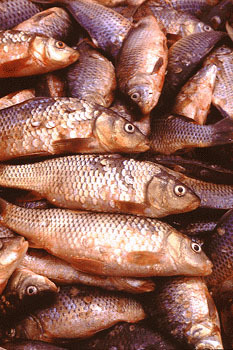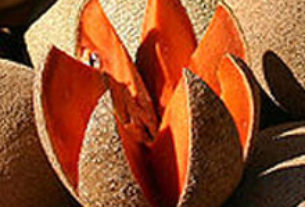Last month’s column presented the first part of an alphabetized list of Mexico’s most popular eating varieties of fish and shellfish, expanded beyond the literal meaning of mar – ocean – to include freshwater species. Throughout Lent, markets and supermarkets have been selling them as fast as they come in. (Some imported items are included in the list because they are eaten frequently, especially at this time of year.)
As Semana Santa – Holy Week – approaches, the seafood frenzy grows, and the main menu items in homes and restaurants are bound to be pescados y mariscos. One women’s magazine here in Mexico presents a different menu of suggested meals each week, and for Semana Santa there are no less than fifteen different seafood dishes recommended to be served in seven days. Yes, that’s more than two a day, with breakfast seemingly the only meal without it, although seafood soup is an early morning favorite in market stalls and coctelerías – stands serving fish and shellfish cocktails.

This popular caldo can contain almost any type of seafood, and the more variety, the merrier. Other regional variations aside, the Veracruz version, called vuelve a la vida – “return to life” – is the hands-down favorite, so named because of its purported effectiveness as a hangover remedy.
And there will undoubtedly be some hangovers among those who take the Semana Santa vacation as a chance to spend time partying at the beaches, lakes, rivers, and balnearios, or large, resort-type pools. Sabado de Gloria – Holy Saturday – requires (by tradition, not church law) that people douse each other with water, and those who haven’t joined the exodus to the beaches are likely to be hit by water balloons dropped from second story windows in town. After that, there’s probably nothing like a good shrimp cocktail to get into the spirit of the occasion.
For some, Semana Santa is a time for diversion, and for others, introspection. But whether spending the days on the beach or at religious processions, nearly everyone will be sitting down to meals originating in Mexico’s oceans, lakes and rivers.
As with last month’s recipes, those following the guide have been written to be prepared with whatever fish and shellfish are available in your local market. No matter what those may be, they are sure to be enhanced by a taste of Mexico.
Langosta: lobster, a high-end restaurant favorite in Acapulco, Puerto Vallarta and other resort towns. The Baja California Peninsula spiny lobster fishery was accredited in 2004 by the Marine Stewardship Council. It is the first community fishery in the developing world to meet the MSC’s criteria for ecologically sustainable fisheries.
Langostino: pelagic red crab, found in the Sea of Cortez and used interchangeably with lobster meat in empanadas and enchiladas.
Lenguado: flounder, caught in the Sea of Cortez. In Baja California, flounder is most often served as a filet stuffed with seafood – filete relleno – or breaded and fried – filete empanizado.
Lisa: mullet, an inhabitant of the lagoons and rivers off Mexico’s southern Pacific coast. Mullet is most often dried or smoked, methods of preservation common in the hot regions, where refrigeration is at a premium.
Macarela: mackerel, which inhabits both the Pacific and Gulf coasts of Mexico. It is frequently either smoked or canned, and the canned version is used in the same way as canned sardines (see sardina, below.)
Mejillones: mussels, abundant along the Gulf coast. They are most often steamed, marinated, or prepared a la plancha – opened on a hot comal rather than steamed open.
Merluza: hake, imported from north Atlantic waters, but common in the fish markets during the Lenten season.
Mero: grouper, one of the most appreciated fish in Mexico. In the central part of the country it is said, with fond regard to food, “de la tierra el carnero y del mar el mero,” meaning that the best meat is lamb and the best fish is grouper.
Mojarra: tilapia, of which there are twelve different species in Mexico, including the tilapia zillii; the eucinostomus genus, which includes flagfin mojarra; and the diapterus, commonly known as rhomboid mojarra. The word mojarra has been translated as many things, from bluegill to sunfish, so it is no wonder that several kinds of freshwater fish in the market are likely to be dubbed “mojarra” for lack of another name.
Molusca bivalvo: scallop (see callo in Part One)
Ostion: oyster, found in nearly all Mexican waters, although no longer harvested in parts of the Gulf that have become polluted. Oysters are used in seafood cocktails and also eaten on the half shell.
Pámpano: pampano, which inhabits the warm Gulf waters off the coast of Campeche, where it is often prepared en escabeche, marinated with pickling spices.
Pargo: barred snapper or yellow snapper, both species going by the common name pargo and abundant in the Mexican Pacific. A characteristic way of cooking this fish is zarandeado, grilled whole, butterflied, over a wood fire on a woven branch rack called a zaranda.
Pejelagarto: gar, found in the eastern coastal state of Tabasco, where it is used in everything from tamales to tostadas. In the Villahermosa market, the needle-nosed fish is sold whole, impaled on long sticks to make it easy to place directly on the grill and turn.
Perca: perch, of which there are fourteen different species in México, in the waters off northern Baja.
Percebes: goose barnacles, common along Mexico’s Pacific coast, especially around Zihuatenejo. Although they look like clams, they are prized by gourmets for their taste, which resembles that of sea urchin ( erizo.)
Pez espada: swordfish, caught off Mexico’s Pacific coast. This is true swordfish, xiphias gladius, not to be confused with sawfish, pristis pectinata, which is a north Atlantic fish often sold as “swordfish steaks” in US restaurants.
Platija: sole, a delicate-fleshed, superb eating fish. Deep sea sole and petrale sole both inhabit Mexican waters.
Pulpo: octopus, a favorite for stews, soups and seafood cocktails. Pulpo en escabeche, octopus marinated with pickling spices, then boiled and served cold, is a popular Semana Santa dish.
Raya: stingray, found in profusion in Baja California’s Sea of Cortez. They are often punched out into rounds to resemble scallops and prepared as such.
Robalo: snook, sometimes taken for sea bass ( cabrilla) or translated as such on menus. Nine different species of snook are found in Mexican waters.
Sábalo: tarpon, of which two species are found in México, one in the Pacific and another in the Gulf of Mexico and the Caribbean. It is frequently either grilled or cooked in coconut milk, the latter being a Caribbean preparation.
Salmón: salmon, an imported food that has become increasingly popular in recent years. Nearly every major supermarket now sells frozen salmon, smoked salmon, and even salmon and cream cheese spreads.
Sardina: sardine, of which the Pacific sardine is abundant in Mexican waters and is raised in industrial hatcheries as bait for the bluefin tuna ( atún aleta azul) that is exported to Japan. Sardines are canned with tomatoes, with chiles, and in oil. They are used to stuff chiles, layered on the stuffed tortillas called panuchos, cooked in a casserole called budín de sardines – “sardine pudding” – and eaten as a snack on tostadas and crackers.
Shote: freshwater snail found in Chiapas, near the Guatemalan border, and soaked with the anise-tasting hoja santa leaves before being cooked in broth.
Sierra: kingfish, a firm-fleshed fish commonly prepared en escabeche – marinated in pickling spices – in the Yucatan, where it is also called esmedregal.
Tiburón: shark, several species of which are abundant in the Gulf of Mexico. Mexican ichthyologists recently discovered a new species of smoothhound shark and believe there may be others yet to be discovered. Artisanal shark fisheries have provided food and employment in Mexico for several years.
Tortuga: turtle, now illegal to catch. Gathering and selling the eggs is also prohibited. The galápago – terrapin – is often erroneously called tortuga, though its meat is said to be far more tender.
Totuaba: totuaba, a rare, endangered and protected species in the Sea of Cortez. Although prohibited, locals still catch it from time to time and say it is an excellent eating fish.
Trucha: trout, found in the rivers and streams of Mexico’s high central plateau, where trout fishing is popular and trout hatcheries abound. The hatcheries often have adjoining restaurants where several different preparations of the fish are offered, including al mojo de ajo – with copious amounts of fried garlic- and al epazote, seasoned with the pungent herb epazote and onions.
- Panuchos de Pescado: Yucatán Fish Panuchos
- Jalapeños Rellenos con Pescado Ahumado y Queso al Horno:Baked Jalapeños Stuffed with Smoked Fish and Cheese
- Pescado en Escabeche: Marinated Fish Steaks

